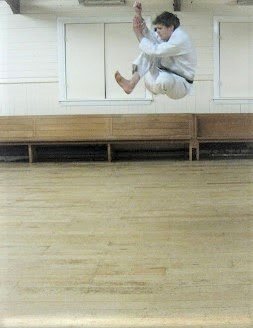I was recently asked to talk about why there are jumps in the Shotokan kata, which pre-Shotokan just weren't there. Now before I answer that question, I want to emphasize that my answer to this question is second-hand; that is, and obviously, I can only reply to this question by what I’ve been told from some of my seniors here in Japan. That being said, I think the answer is logical: they are good for training and better for applying this these kata movements. In sum, pragmatic and, I have to say, 'cool' as well. Therefore, I will share this with you today.
As you will
know, older versions of the kata, for the most part, do not have many of these jumps. To make
the list, not too exhaustive, I will focus on the standard Shotokan Kata featuring
tobi-waza (excluding the majority of low jumps and Nidan-keriwaza). These kata are Heian Godan
(Pinan Godan), Enpi (Wanshu), Kanku Sho (Kosukun Sho/Kushanku Sho), Unsu
(Unshu) and Meikyo (Rohai).
In most
cases, up until Shotokan, the jumps in these kata were 'grounded turns'; nevertheless, the actual applications were the same.
So, who and
why were the jumps added???
Apparently,
Funakoshi Yoshitaka (Gigo) Sensei, overseen by Funakoshi Gichin Sensei, decided
to increase the athleticism of the turns. However, this extra requirement of muscular
spring was “…to strengthen the lower body (for the application of the
respective waza being applied)”. Put another way, “when the kata is practiced
by oneself, there is no training partner to throw”; thus, one throws
themselves. You see, ‘the jump trains the main muscles you actually use to
throw someone in addition to the turns (which tell us the direction of ‘push
and pull’/leverage in order to make that particular throw).
 |
| Meikyo Kata: The SANKAKU-TOBI. |
Nevertheless, it doesn’t end there. There are of course exceptions. For example, the Sankaku-tobi of Meikyo is literally a takedown utilizing the combination of tenshin (rotation) and juryoku (gravity) in combination with ‘migi hiji sasho ate’.
The second jump in Kanku Sho is a ‘mikazuki-geri/migi sasho-ate’ followed immediately by ‘a level and sharp falling twisting jump’. Within this is, of course, is the ushiro-kekomi completed by a duck’. In this case, the ‘jumping action’ is “…to enable immediate multi-directional keriwaza”. Indeed, Unsu has a high jump with the same meaning of Kanku-Sho; however, it also can be applied when one’s leg is grabbed (you jump and kick the opponent with the grounded foot—mikazuki-geri, free the other leg, then you kick them again—with ushiro-kekomi). Alteratively, it is also a template for all five versions of Kani-basami.
 |
| Here I'm using Kani-Basami in Jiyu Kumite during an exam. |
Just to confirm (and going in reverse order): the jump in Enpi and the first jump in Kanku-Sho are both ‘Kata-Guruma’. Lastly, the jump in Heian Godan is ‘Seoi-Nage’.
I need to
go, ever so slightly, off topic here. As I have written about so much in the
past, Asai Tetsuhiko Sensei stressed ‘three types/styles/modes’ of karate:
“standing, grounded and jumping”. He topped these off with his one of his
‘tokuiwaza’—TENSHIN (rotating/spinning). When you combine these aspects, and
think about the aforementioned applications, I think that one can have a
foundational understanding and unpredictability of Asai Karate.
As already mentioned, the strength benefits from jumping cannot be underestimated. Plyometric exercises and jumping techniques not found in the kata irrefutably have their benefits: especially pertaining to ‘increasing explosiveness’. In addition to this, “…accuracy determined by body control are also useful skills for budoka”; accordingly, the physical education gained from various jumps is significant.
I’d like to wrap up by saying what I always say about kata and their respective oyo (application). Yes, the solo practice of the kata is important as we can really develop our form; furthermore, we can do techniques at full-speed/with maximum capacity without needing to ‘put the breaks on’ (which is obviously essential to avoid injuring training partners). Nonetheless, solo practice is not enough on its own. Of course, it is impossible to make the techniques in the kata ‘functional’ without extensive partner training of the respective kata movements. This point cannot be overstated nor overlooked! Otherwise, kata is nothing more than movement resembling karate, but with no real meaning. Kata in such a shallow way might function as a method of physical fitness/strengthening, however, if that is the case, I believe it would be much more productive spending more time doing resistance training. This in itself is proof that kata includes this aspect, but must also include maximum applicability in conjunction with optimal form and visa-versa.




No comments:
Post a Comment